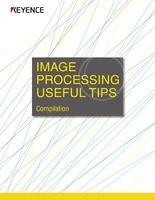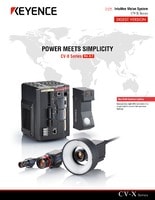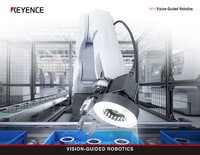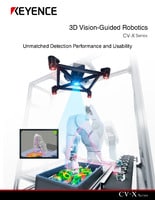History of Machine Vision : Camera
The camera is now ubiquitous in our daily life as well as in image processing, but do you know how it was born and how it evolved? This booklet describes the evolutionary history of the camera from its birth to the current mainstream digital camera.
Birth of the Camera
The history of camera images dates back to the B.C. era when “camera obscura,” which means “dark room," was the ancestral device of the current camera. The camera obscura was an optical device that projects an upsidedown image of an object using the light coming into a dark room through a small hole. It used exactly the same mechanism as pinhole cameras. Eventually, from the 16th century, it was developed into a device composed of a lens, dark box, and reflecting mirror. This device was used as a drawing aid when artists made sketches of landscapes and drew portraits.
In 1839 a Frenchman, Daguerre, invented the daguerreotype (silver-plate photography) camera. Then about 30 years later, Maddox invented the dry plate in Britain. It is said that the oldest photo in Japan was taken with the daguerreotype camera.
With these inventions, the age when the subject was portrayed by human hands came to an end, and the age of the camera, in which the captured image is recorded using photosensitive material, began.
Film (Silver Halide) Camera
The photosensitive material, on which captured images are recorded, has been continuously changing for over 170 years since the camera was born. Starting from the silver plate, the photosensitive material evolved to the wet plate and then to the dry plate, and eventually film rolls were invented. Film rolls enabled cameras to record multiple photos on one roll by advancing the film one frame at a time. In response to this progress, various types of film cameras were developed to accept differently-sized films such as 16 mm, 4 × 5 cm and 6 × 6 cm. In addition, the half-framed camera, which can double the number of frames on one roll, was introduced to the market. The reason that film cameras are also known as silver halide cameras is because the captured image is recorded by exposing compounds like silver halide to light. The most widespread type of camera film used was the 135 film (better known as 35 mm film), which was the standard size of films used for movies. Reversal film, which produces vivid colors, was also used to make slides.
Popularization and Miniaturization Promoted by the Development of Electronics
Surprisingly, the application of electronic technologies to cameras started fairly early, dating back to the 1950s when the electronically-controlled automatic exposure meter was developed. This innovation freed photographers from the troublesome procedure of adjusting shutter speeds and apertures. Further, spurred by the introduction of the autofocus (automatic focusing) function and automatic strobe lights, the camera gradually became popular among ordinary people. At the same time, the transistors used for electronic control circuits were replaced by ICs, which expedited the miniaturization of the camera. The trends of popularization and miniaturization have been further accelerated with the development of digital cameras.
Digital Camera
When film cameras were in their heyday in the 1980s, the camera world marked another development. It was the invention of the digital still camera. This newcomer fascinated the public with its convenient features: the elimination of the DPE steps (development, printing, and enlargement) and the immediate display of captured images on the LCD monitor for users to check them. Less than 20 years after its release, it has surpassed the film camera in both production and shipment volumes, taking the lead in the camera industry.
The captured image is converted into pixels using semiconductor image sensors (image sensing devices) and photodiodes that detect light. For example, a five megapixel digital camera creates a full array of image data using five million tiny photodiodes.
What Is the Difference between a Film Camera and a Digital Camera?
The biggest difference lies in the process to record a captured image. The film used for silver halide cameras played two roles at a time: capturing the image and recording the image. On the other hand, the image sensor on a digital camera divides these roles by first capturing the image and then recording the image in semiconductor memory. This explains how two or more captured images are recorded on one frame if you forget to advance the film and how recording memory can be repeatedly used by deleting the image data stored in it. Moreover, the film camera records the captured images as they are, while the digital camera performs sampling (constant quantization of the changes in exposure) before recording the image, which makes it possible to acquire highly stabilized and reproducible image data.
CCD Camera
The evolution of the digital camera continues with the development of the CCD (charge-coupled device) image sensor which increases the photosensitivity of photodiodes. CCDs are used in a variety of cameras such as compact microscope cameras, camera cell phones, compact digital cameras, and large DSLR cameras. The CCD provides the functionalities to meet a wide range of application needs including those for astrophotography and security surveillance, and is also used for the autofocus function and for exposure control. Furthermore, 3D cameras, which have been recently introduced into the market, capture a realistic image exactly as the human eye would recognize the object by equipping a CCD camera with two lenses. On the other hand, the use of the CMOS image sensor, which has often been used for night vision cameras, is increasing.
![A Technical History of Image Processing Vol.1 [Camera]](/img/asset/AS_46814_L.jpg)




![The Latest Image Processing Applications [Transportation Industry]](/img/asset/AS_71759_L.jpg)

![The Latest Machine Vision Inspections [Food and Medical Industries]](/img/asset/AS_72814_L.jpg)








